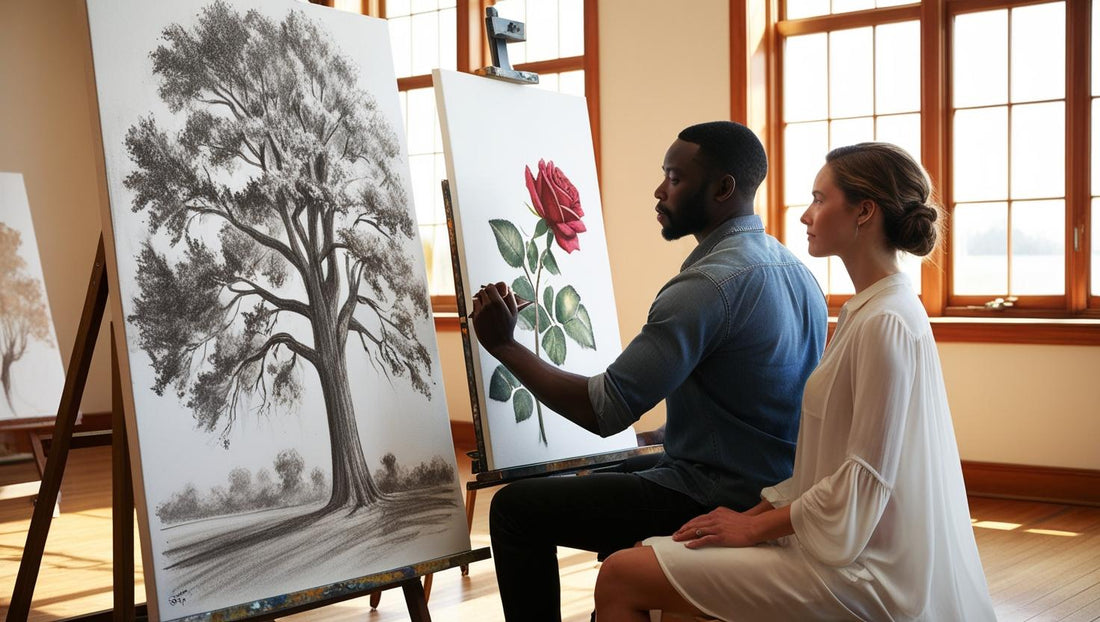
The secret to good drawing: mastering proportions, perspective and shading
Drawing is more than just putting a pencil on paper. It's a powerful way to express emotions, tell stories, and capture the beauty of the world around us. Yet, the final result often doesn't quite match what you imagined. Why? Because behind every great piece of art lie three fundamental elements: proportion, perspective, and the subtle interplay of light and shadow. In this article, we'll explore these essential techniques to transform your sketches into captivating works and take your art to the next level.
Proportions: the art of visual accuracy
Artistic proportions are the foundation of a harmonious design. They ensure that each element fits naturally into the whole, thus avoiding unintentional distortions that can ruin the illusion of realism.
How do you go about drawing a human face or body? Do you follow specific rules or do you let your intuition guide your pencil?
Here are some techniques to improve the accuracy of proportions :
- The guide line method : drawing vertical and horizontal axes helps align elements and avoid glaring errors.
- Comparative measurements : Compare the size of different parts of the subject (e.g., the length of a hand compared to the face) for better consistency.
- The canon of human proportions : Did you know that the average height of the human body is approximately seven to eight times the size of the head? An essential guide for drawing realistic figures.
At Horizon World Art , artists share their work, providing an invaluable source of inspiration. Our online art gallery features a diverse array of talents constantly exploring and perfecting their mastery of proportion.
Perspective: giving depth to the drawing
Perspective in drawing is what transforms a flat scene into a vivid, immersive space. Imagine a landscape with no depth or a building with no relief: the effect would be artificial.
There are several types of perspectives , each tailored to specific needs:
- One-point perspective : Ideal for hallways or roads that seem to stretch on forever.
- Two-point perspective : perfect for representing the corners of buildings and giving a powerful three-dimensional effect.
- Atmospheric perspective : Based on the diminishing of details and the softening of colors with distance, this technique is often used in painting and illustration.
A good exercise is to observe your surroundings : how do lines meet in the distance? The art exhibitions at Horizon World Art feature stunning works that use perspective to create a sense of depth. For example, observe the careful work of perspective in The Louvre from the Tuileries , a work that beautifully captures space and depth.

Shadows and lights: creating volume and relief
Light and shadow are the finishing touches that give character to a drawing. A well-placed shadow can transform a simple shape into a tangible and realistic volume.
Have you ever tried the dramatic effect of a strong contrast between light and shadow in your drawings?
Here are some tips to refine your technique:
- Determine the light source : Identify where the main light is coming from to cast consistent shadows.
- Using Self and Cast Shadows : A self shadow is one that falls directly on the object, while a cast shadow is one that is cast onto another surface.
- Vary the intensity of the shadows : hard shadows create a dramatic effect, while soft shadows give a more natural look.
This mastery is the key to creating realistic and expressive drawings . Notice the subtle yet powerful impact of light and shadow in Liaison 2 , which demonstrates the importance of these elements in artistic composition.

Equipment and techniques: equip yourself well to draw better
Good drawing starts with the right tools. Whether you're a beginner or an experienced artist, choosing the right materials can significantly improve your rendering. Here are some essential items to have in your artist's kit:
- Pencils of different hardnesses : from 2H (very light) to 6B (very dark) to vary the texture and contrast effects.
- Kneaded eraser : perfect for blending shadows and making gentle corrections without damaging the paper.
- Blender or cotton swab : ideal for blending shadows and creating subtle transitions.
- Quality paper : a suitable grain allows for better capture of texture and details.
- Felt-tip pens and ink pens : for finishing touches and light line drawings.
By experimenting with various mediums and techniques, you can enrich your personal style and discover new approaches to bringing your ideas to life.
Horizon World Art: Your Online Art Gallery
To further your drawing skills and share your art with the world, explore the resources offered by Horizon World Art . This digital art platform offers you a space to showcase your work and participate in physical exhibitions . Get inspired by other members' creations and grow your talent within a passionate community.
The secret to successful drawing lies in practice and experimentation. By working on your proportions, playing with perspective, and refining your mastery of shading, you will discover a whole new dimension of art .
Whether you're a beginner or an experienced artist, feel free to share your creations on Horizon World Art , a space where artists support each other and where works are highlighted through captivating art exhibitions. Ready to push your artistic boundaries ?
